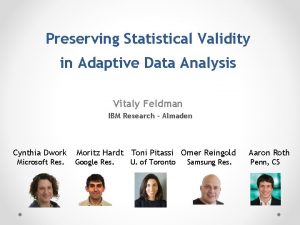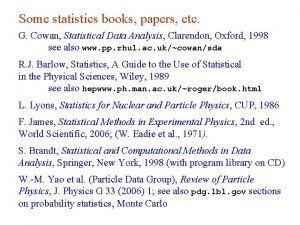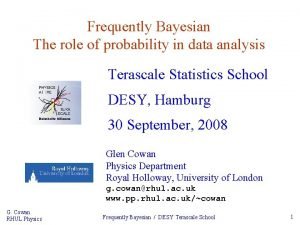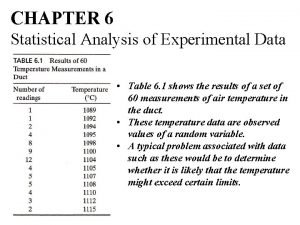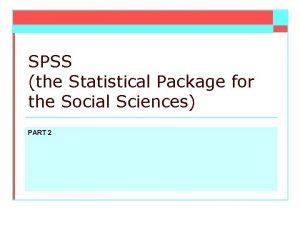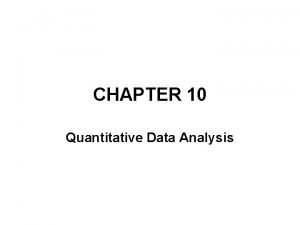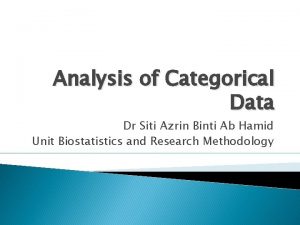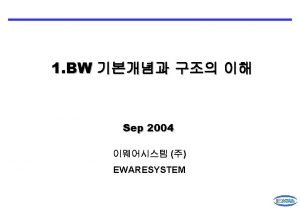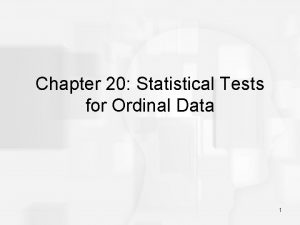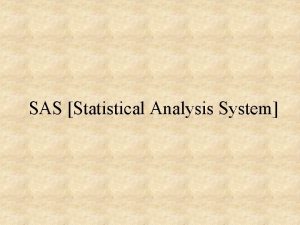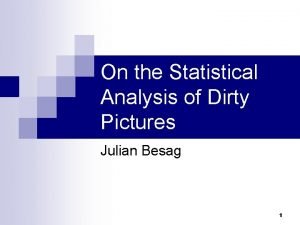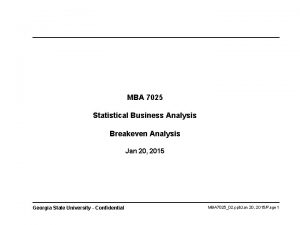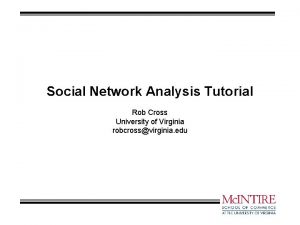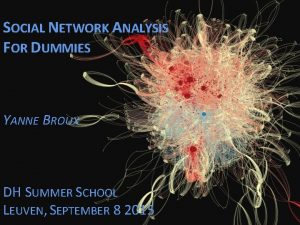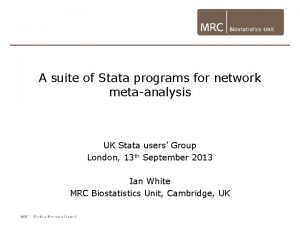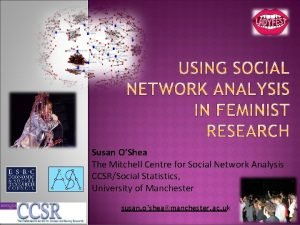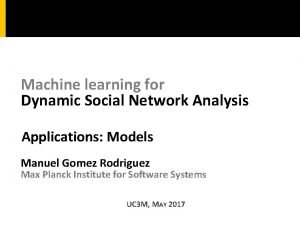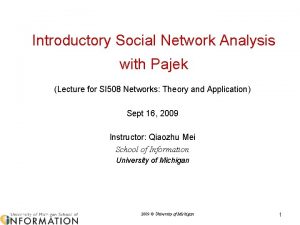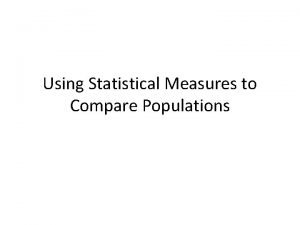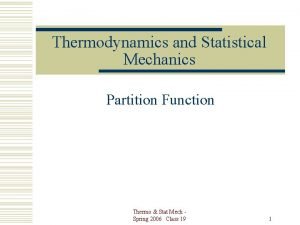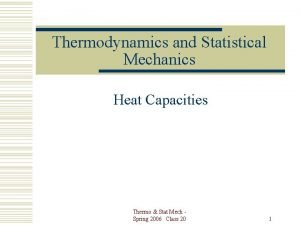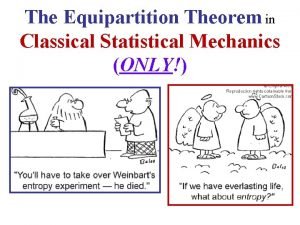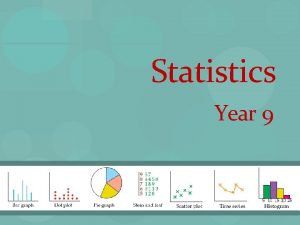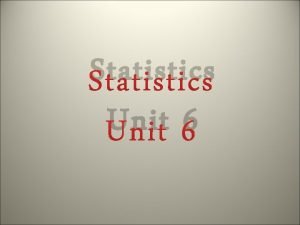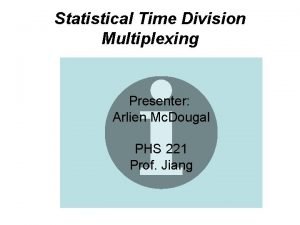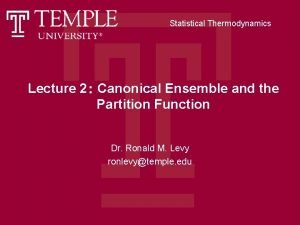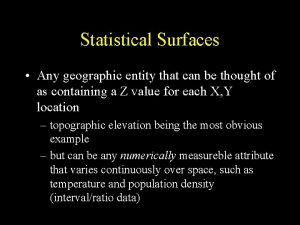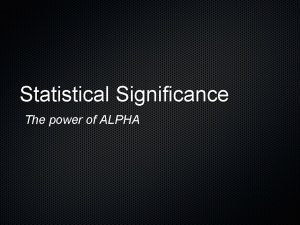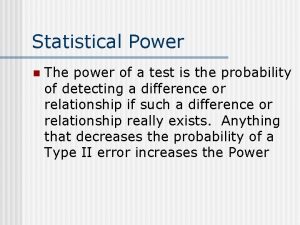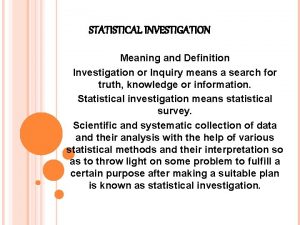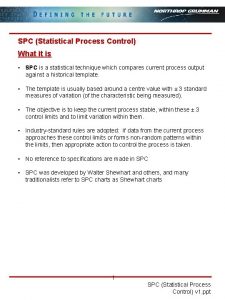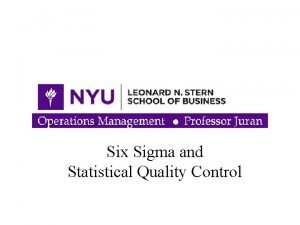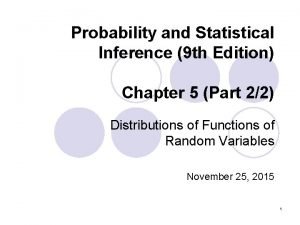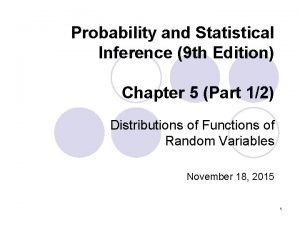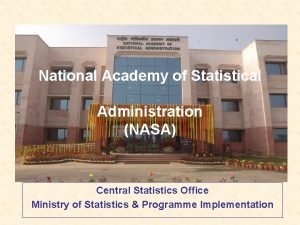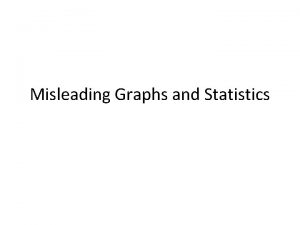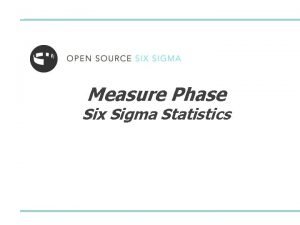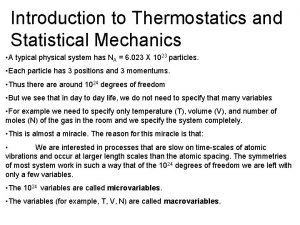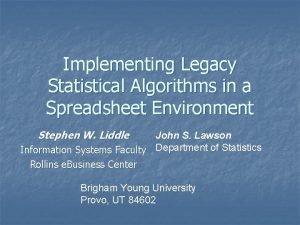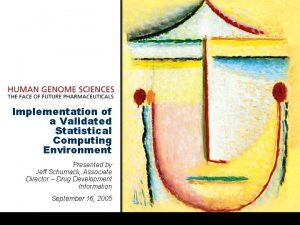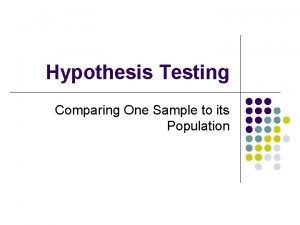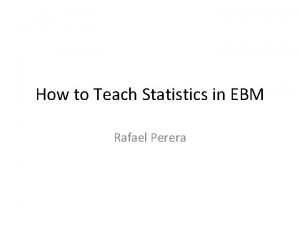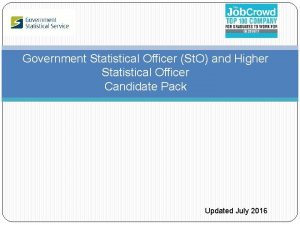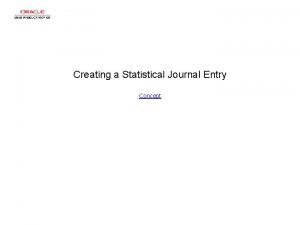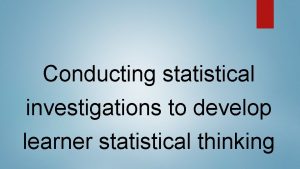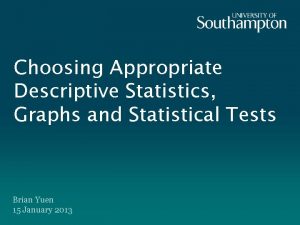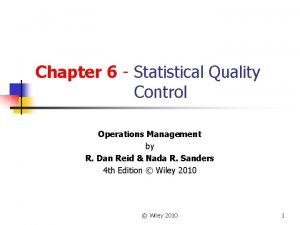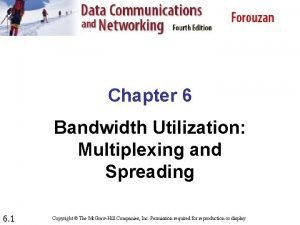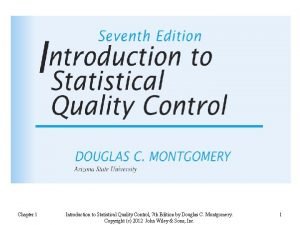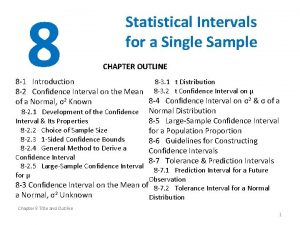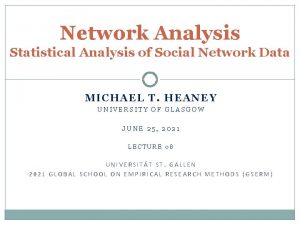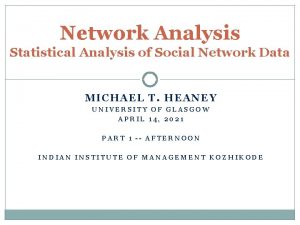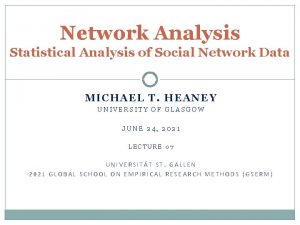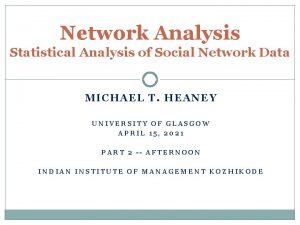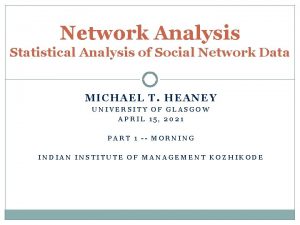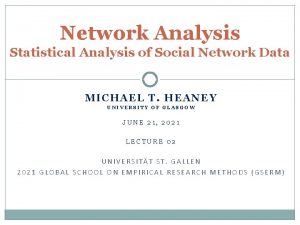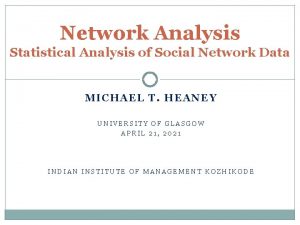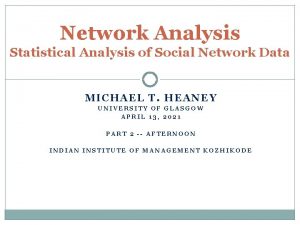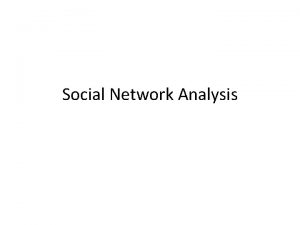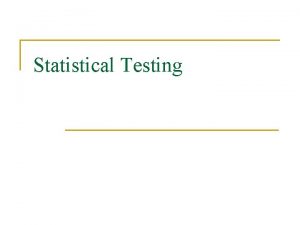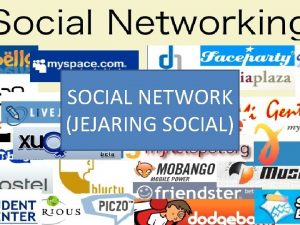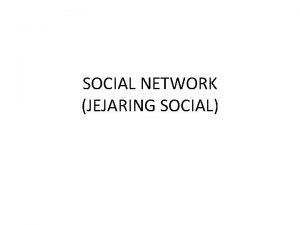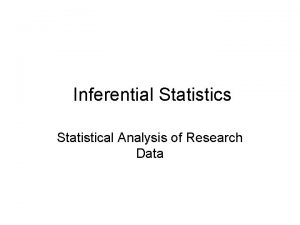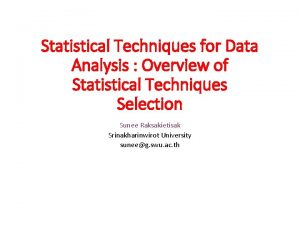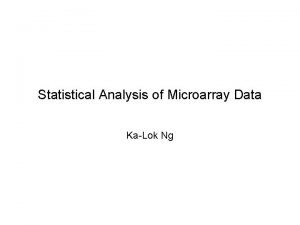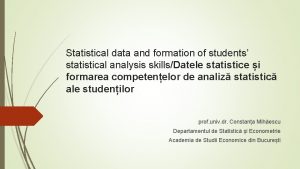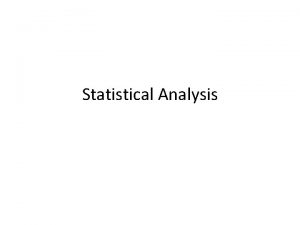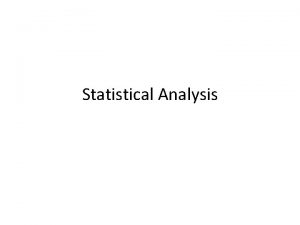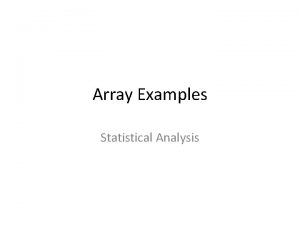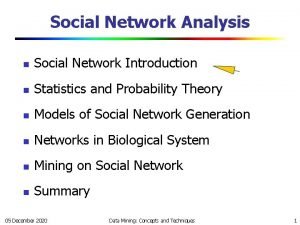Network Analysis Statistical Analysis of Social Network Data





































































- Slides: 69

Network Analysis Statistical Analysis of Social Network Data MICHAEL T. HEANEY UNIVERSITY OF GLASGOW JUNE 21, 2021 LECTURE 01 UNIVERSITÄT ST. GALLEN 2021 GLOBAL SCHOOL ON EMPIRICAL RESEARCH METHODS (GSERM)

Introduction

Introduction Definition Motivation Data Gathering Relational Thinking

What Are Networks? �Networks are patterns of relationships that connect individuals, institutions, or objects (or leave them disconnected).

What Are Networks? �Networks are patterns of relationships that connect individuals, institutions, or objects (or leave them disconnected). EXAMPLES � The lineage of a family � Giving and receiving grooming among gorillas � Patterns of contracts among firms � Individuals’ co-memberships in organizations � A computer system that allows people to form friendships or meet potential mates � Citations between academic papers

Why Study Networks? �Networks are substantive phenomena we care about (e. g. , Facebook, a health care network, a policy network) �We may theorize that access to networks affects an outcome we care about (e. g. , Does access to social support through family networks affect mothers’ success in raising their infants? ) �Network analysis may provide a methodological approach that solves a research problem (e. g. , Which worker at an office has access to the most timely information? )

When to Study Networks? �All human activity is embedded within networks, so anything could be studied using network analysis.

When to Study Networks? �All human activity is embedded within networks, so anything could be studied using network analysis. �But just because network analysis is possible does not mean that it is desirable.

When to Study Networks? �All human activity is embedded within networks, so anything could be studied using network analysis. �But just because network analysis is possible does not mean that it is desirable. �The question we want to ask is: When in the network aspect of phenomenon particularly pertinent to the social dynamics that matter to us?

Some Good Opportunities for Network Analysis �When the informal organization of a system competes with or replaces formal organization

Some Good Opportunities for Network Analysis �When the informal organization of a system competes with or replaces formal organization �When formal organization has multiple levels or complex formal inter-relationships (e. g. , departmental interaction in an international firm)

Some Good Opportunities for Network Analysis �When the informal organization of a system competes with or replaces formal organization �When formal organization has multiple levels or complex formal inter-relationships (e. g. , departmental interaction in an international firm) �When access to information is especially important to the outcomes in question (e. g. , understanding why consumers switch their purchasing behavior after exposure to social media)

Some Good Opportunities for Network Analysis � When the informal organization of a system competes with or replaces formal organization � When formal organization has multiple levels or complex formal inter-relationships (e. g. , departmental interaction in an international firm) � When access to information is especially important to the outcomes in question (e. g. , understanding why consumers switch their purchasing behavior after exposure to social media) � Coordination, cooperation, or trust is a key part of a process (e. g. , understanding the composition of cross-party coalitions among legislators)

Data-gathering Approaches Multiple data-gathering approaches are valid: �Ethnography �Interviews �Surveys �Experiments �Web scraping �Archival analysis

Example: Ethnography �Mario Luis Small, Unanticipated Gains: Origins of Network Inequality in Everyday Life (Oxford 2009) � Observation of and interviews with mothers whose children were enrolled in New York City childcare centers. Qualitative analysis. � Argues that “how much people gain from their networks depends fundamentally on the organizations in which those networks are embedded. ” (iv) � Networks matter not only because of size, but because of “the nature, quality, and usefulness of people’s networks. ” � Demonstrates the development of social capital.

Example: Interviews �Mildred A. Schwartz, The Party Network: The Robust Organization of Illinois Republicans (Wisconsin, 1990). � Interviews with 200 informants within the Illinois Republican Party. One-hour interviews repeated up to three times with each informant. � Argues that although hierarchy is a part of a party structure, they do not function as a single hierarchy or oligarchy. They are decentralized and loosely coupled. � Networks are critical to party adaptation over time.

Example: Surveys �Mark Granovetter, Getting a Job: A Study of Contacts and Careers (Chicago, 1974) � A random sample of residents of Newton, Massachusetts. Asked for information about how they learned about job opportunities. � Found that new information about job opportunities was more likely to be obtained by people with who respondents had “weak ties” rather than “strong ties. ” � “Weak ties” are more useful for communicating new information, while “strong ties” tend to communicate redundant information.

Example: Experiments �David W. Nickerson, “Is voting contagious? Evidence from two field experiments, ” American Political Science Review (February 2008). � A field experiment within two different get-out-the-vote campaigns. Examined how the voting behavior of other persons in a household is affected by communication with one person in the household. � Found that 60% of the increased propensity to vote (from the get -out-the-vote campaign) is passed onto the other member of the household.

Example: Web Scraping �Lada Adamic and Natalie Glance, “The Political Blogosphere and the 2004 U. S. Election: Divided They Blog”, Proceedings of the 3 rd international workshop on Link discovery, March 2005 �Examines linking patterns and discussion among bloggers �Finds polarized networks with more interlinkage in conservative blogs than liberal blogs

Example: Archival Analysis �John W. Mohr, “Soldiers, Mothers, Tramps and Others: Discourse Roles in the 1907 New York City Charity Directory, ” Poetics (June 1994). � Examined types of eligible clients in the 1907 New York City Charity Directory. Examined how identities emerged based on similarities of which social categories were grouped together. � Treatment depended on whether status was achieved (e. g. , soldiers) or ascribed (e. g. , mothers). Distinctions were commonly made based on deservingness and gender.

Methods of Analysis Vary �Qualitative �Graphical �Quantitative – Descriptive �Quantitative – Analytical

Methods of Analysis Vary � Qualitative Ø Observe how some actors use their networks differently than others. � Graphical Ø Graph a network structure and talk about its implications. � Quantitative – Descriptive Ø Describe the size of networks and what types of actors are contained in them. � Quantitative – Analytical Ø Ø Ø Include measures of network structure as independent variables in regression analysis. Make the existence of a network tie the dependent variable in a regression. Test whether theoretical construction of a network is consistent with its empirical realization (e. g. , should a network be centralized, decentralized? )

Relational Thinking �Much of social science emphasizes the individual as a unit of analysis. Ø Why do some businesses work more collaboratively than others? �Network analysis tends to place a strong emphasis on the relationship (or “the dyad”) as a unit of analysis. Ø Why do firms A and B form a joint partnernship? �It is sometimes difficult to get our minds around a relational approach to theorizing. Ø Ø Individual thinking: “It’s not you, its me. ” Relational thinking: “Its neither you nor me, it’s us. ” Mustafa Emirbayer, “Manifesto for a Relational Sociology” American Journal of Sociology (September 1997).

Questions / Comments ?

Key Concepts

Key Concepts Graphs Matrices Modes

Graphs

Graphs �Social networks can be represented as graphs. �Graphs are made up of nodes (i. e. , actors) that are connected by links (i. e. , relationships). LINK NODE

Nodes and Links �Node = Point, Vertex, Actor, Individual Ø Examples: Person, Firm, Nation-State, City, Organization, Word, Article �Link = Line, Edge, Tie, Connection, Relationship Ø Examples: Joint Venture, Communication, Animosity, Citation, Marriage, Sex, Fighting a War, Co-membership

Types of Links �Undirected vs. directed links �Dichotomous vs. Valued Links

Undirected Links �Undirected links, denoted with a simple straight line, are used whenever it is impossible that there is asymmetry in a relationship. The relationship is inherently symmetric. A B �If A is married to B, then B must be married to A. It is not possible for A to be married to B without B being married to A.

Directed Links �Directed links, denoted with arrowheads, are used whenever it is possible that there is asymmetry in a relationship: � A gives money to B, but B gives nothing to A. A B � B gives money to A, but A gives nothing to B. A B � A and B give money to each other. A B

Dichotomous vs. Valued Links �Dichotomous – either a link exists or it doesn’t (e. g. , either we are friends or we’re not, either two nations are at war or they’re not, either we are married or we are not). Represent with the presence of a line: �Valued – links vary in their strength (e. g. , our friendship may be strong or weak; we may have one friend in common or 3). Represent with varied line formats:

Complete Graphs and Connectivity �Complete Graph – all possible ties exist: �Not a Complete Graph, but a Connected Graph �Not a Connected Graph

Components �Component – the set of all points that constitutes a connected subgraph within a network �Main component – the largest component within a network �Minor component – a component that is smaller than the main component – there may be many minor components

Components MINOR COMPONENT MAJOR COMPONENT

Pendants and Isolates �Pendant – a node that only has one link to a network �Isolate – a node that has no links to a network

Key Parts of a Graph MINOR COMPONENT PENDANT ISOLATE MAJOR COMPONENT

Matrices

Matrices �Networks may be represented as matrices �The most basic matrix is an adjacency matrix Georg Riham Ayshea Vikram Georg 1 0 Riham 0 1 1 0 Ayshea 1 1 1 0 Vikram 0 0 0 1 �A 1 indicates the presence of a link, while a 0 indicates the absence of a link.

Symmetric Matrices �If matrices are symmetric, they may be represented by upper or lower triangle only. Georg Riham Ayshea Vikram Georg Riham 0 Ayshea 1 1 Vikram 0 0 0 �The diagonal may be omitted in this case because it is reflexive.

Modes

Modes �A mode is a class of nodes in a network. �Network analysis typically involves only one mode. �For example, friendships among a group of students would usually be modeled using one mode.

Example: One-Mode Network Friendship Network of workers at a high-tech company (Krackhardt 1992)

Two Modes �Sometimes we want to know how one class of nodes relates to another class of nodes. �Examples: Mode 1 Mode 2 Mentor Mentee People Events Firms Trade Associations Interest Groups Coalitions Legislators Caucuses Nation States Treaties

One-Mode vs. Two-Models �One-models are simpler and more parsimonious. �Two-mode data are more realistic but less parsimonious �We want to think about the trade offs of modeling our data using one mode versus two modes.

From Two Modes to One Mode � Ronald L. Breiger, "The Duality of Persons and Groups, " Social Forces (1974). � If data have two modes, it is possible to reduce the dimensionality of the data using either mode. � Example: If two-mode data have people (Mode X) and organizations (Mode Y), it is possible to reduce them to either people only or organizations only. � Mode X: People linked by their co-membership in organizations. � Mode Y: Organizations linked by common members.

Example: People and Organizations in the USA Antiwar Movement �Two-mode network (Circles=People; Squares=Orgs)

Organizations Linked by Common Members �One-Mode Network

People linked by Organizational Co-membership �One-mode network

Discussion: Which Graph is Most Revealing?

A Polished Example

Advantages vs. Disadvantages Advantages of Going from 2 -mode to 1 -mode �Reduce the dimension of the data �Make it easier to visualize �Focus on what really matters Disadvantages of going from 2 -mode to 1 -mode �Lose information �Confuse the reader �Eliminate the important relationships Depends entirely on your case

Converting Data From One Mode to Two Modes Try it by hand – it’s easy! This twomode network: Calculus Physics Politics Spanish Georg 1 1 0 0 Riham 0 0 1 1 Ayshea 0 1 1 0 Vikram 1 1 0 1 Can be reduced to this one-mode matrix: Georg Riham Ayshea Or this one: Vikram Calculus Georg Calculus Riham Physics Ayshea Politics Vikram Spanish Physics Politics Spanish

Converting Data From One Mode to Two Modes This twomode network: Can be reduced to this one- Georg Riham mode matrix: Ayshea Vikram Georg Calculus Physics Politics Spanish Georg 1 1 0 0 Riham 0 0 1 1 Ayshea 0 1 1 0 Vikram 1 1 0 1 Riham Ayshea Vikram 2 0 2 1 1 2 2 1 1 3 Or this one: Calculus Physics Politics Spanish 2 Physics 2 3 Politics 0 1 2 Spanish 1 1 1 These are affiliation networks – the valued ties can be represented as thickness. 2

Converting Data From One Mode to Two Modes • When we are working with matrices, this transformation is even easier. • One-Mode Network by Rows = Two-Mode Network * (Two-Mode Network)T • One-Mode Network by Columns = (Two-Mode Network)T * Two-Mode Network

More than Two Modes �It is possible for network data to have more than two modes. Example �Mode 1: Firms �Mode 2: Trade Associations �Mode 3: Nations

Lattices are often used to depict and analyze higher-order modal models Ann Mische, Partisan Publics: Communication and Contention across Brazilian Youth Activist Networks (Princeton, 2008).

Another Lattice from Ann Mische

The Limits of Multi-Modal Analysis �Almost all network analysis can be conducted using when one-mode data is on hand. �In many network software programs two-mode measures (e. g. , centrality) can be easily generated. But progress in this area is still moving forward. �Some work has been done on higher-order modes, but work needs to be done to make their analysis practical for social scientists.

Questions / Discussion about Modes?

Development of Social Network Analysis

Origins of Network Analysis �Early social theorists: Durkheim, Marx, and Weber, for example, were interested in the relation between the individual and society �George Simmel: web of group affiliations; the triad �Jacob Moreno: First efforts to map social structures

Multidisciplinary Advances, 1940 -1970 �Mathematics / graph theory �Political Science �Sociology �Anthropology

Sociological Consolidation, 1970 -1995 �The Harvard School -- Harrison White and colleagues �Sociometric advances �John Padgett, multiple networks and robust action

Network Explosion, 1995 -2010 �Physics and networks (Duncan Watts) �Economics and game theory (Mathew Jackson) �Public Health (Christakis and Fowler) �Adoption in many fields

Institutionalization, 2010 -present �Growth of network associations �The concept of “network science” �Wider availability of software

Discussion �How could network science fit into your discipline and research fields? �What are some promising areas for growth?

Good Introductory Readings � Albert-Laslo Barabasi, Linked (Penguin 2003). � Stephen P. Borgatti et al. , Analyzing Social Networks (Sage 2013) � Lincton C. Freeman, “Centrality in Social Networks: I. Conceptual Clarification, ” � � � � � Social Networks (1979). Linton C. Freeman, The Development of Social Network Analysis (Empirical Press 2004). Matthew O. Jackson, Social and Economic Networks (Princeton 2008). Eric E. Kolaczyk and Gabor Csardi, Statistical Analysis of Network Data with R (Springer 2014). John Levi Martin, Social Structures (Princeton 2009) Mark Newman, Networks: An Introduction (Oxford 2010). Mark Newman et al. , The Structure and Dynamics of Networks (Princeton 2006). Garry Robins, Doing Network Research (Sage 2015) John Scott, Social Network Analysis: An Handbook (Sage, 2000. Stanley Wasserman and Katherine Faust, Social Network Analysis: Methods and Applications (Cambridge 1994). Issues of the journals, Social Networks, Network Science, and the Journal of Social Structure
 Preserving statistical validity in adaptive data analysis
Preserving statistical validity in adaptive data analysis Cowan statistical data analysis pdf
Cowan statistical data analysis pdf Cowan statistical data analysis pdf
Cowan statistical data analysis pdf Statistical analysis of experimental data
Statistical analysis of experimental data Statistical package for social sciences
Statistical package for social sciences Apa itu social thinking
Apa itu social thinking Social thinking social influence social relations
Social thinking social influence social relations Statistical treatment of data example
Statistical treatment of data example What statistical test for categorical data
What statistical test for categorical data Statistical data warehouse
Statistical data warehouse T test ordinal data
T test ordinal data Statistical treatment of data example
Statistical treatment of data example Statistical analysis system
Statistical analysis system On the statistical analysis of dirty pictures
On the statistical analysis of dirty pictures Multivariate statistical analysis
Multivariate statistical analysis Statistical business analysis
Statistical business analysis Conjoint analysis in r
Conjoint analysis in r Social network analysis tutorial
Social network analysis tutorial Social network analysis for dummies
Social network analysis for dummies Stata network analysis
Stata network analysis Mitchell centre for social network analysis
Mitchell centre for social network analysis Machine learning social network analysis
Machine learning social network analysis Pajek
Pajek Procedures of data collection
Procedures of data collection Data preparation and basic data analysis
Data preparation and basic data analysis Data acquisition and data analysis
Data acquisition and data analysis Content analysis of secondary data
Content analysis of secondary data Government statistical service graduate scheme
Government statistical service graduate scheme Using statistical measures to compare populations
Using statistical measures to compare populations Partition function in statistical mechanics
Partition function in statistical mechanics Statistical mechanics
Statistical mechanics Equipartition theorem proof
Equipartition theorem proof Statistical displays
Statistical displays Types of statistical questions
Types of statistical questions Statistical tdm
Statistical tdm Statistical thermodynamics is a study of
Statistical thermodynamics is a study of What is microcanonical ensemble
What is microcanonical ensemble Bmk+
Bmk+ Statistical surfaces can be or
Statistical surfaces can be or Statistical significance p value
Statistical significance p value Statistical power table
Statistical power table Statistical nlp
Statistical nlp Statistical investigation definition
Statistical investigation definition Statistical process control ppt
Statistical process control ppt Statistical symbols and meanings
Statistical symbols and meanings Proof of chebyshev's inequality
Proof of chebyshev's inequality Probability and statistical inference 9th solution pdf
Probability and statistical inference 9th solution pdf National academy of statistical administration
National academy of statistical administration Misleading graphs statistics
Misleading graphs statistics 3 sigma
3 sigma Statistical methods of demand forecasting
Statistical methods of demand forecasting Statistical vs deterministic relationship
Statistical vs deterministic relationship Relation between partition function and internal energy
Relation between partition function and internal energy Statistical algorithms
Statistical algorithms Statistical computing environment
Statistical computing environment Null hypothesis test formula
Null hypothesis test formula Statistics
Statistics Statistical officer
Statistical officer Statistical methods of demand forecasting
Statistical methods of demand forecasting Numerical datum crossword puzzle clue
Numerical datum crossword puzzle clue Statistical journal entry example
Statistical journal entry example Statistical investigations examples
Statistical investigations examples Partition function in statistical mechanics
Partition function in statistical mechanics Statistical test flow chart
Statistical test flow chart What is a statistical syllogism?
What is a statistical syllogism? Sqc of filling processes
Sqc of filling processes Distinguish between synchronous and statistical tdm.
Distinguish between synchronous and statistical tdm. Introduction to statistical quality control montgomery
Introduction to statistical quality control montgomery Statistical treatment
Statistical treatment Statistical intervals based on a single sample
Statistical intervals based on a single sample
